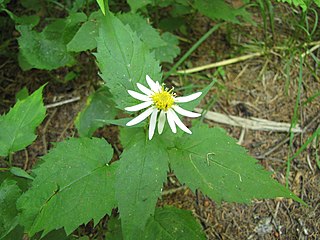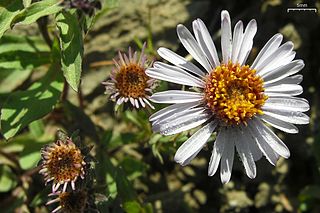
Eurybia macrophylla, commonly known as the bigleaf aster, large-leaved aster, largeleaf aster or bigleaf wood aster, is an herbaceous perennial in the family Asteraceae that was formerly treated in the genus Aster. It is native to eastern North America, with a range extending from eastern and central Canada through the northeastern deciduous and mixed forests of New England and the Great Lakes region and south along the Appalachians as far as the northeastern corner of Georgia, and west as far as Minnesota, Missouri and Arkansas. The flowers appear in the late summer to early fall and show ray florets that are usually either a deep lavender or violet, but sometimes white, and disc florets that are cream-coloured or light yellow, becoming purple as they mature. It is one of the parent species of the hybrid Eurybia × herveyi.

Eurybia surculosa, commonly known as the creeping aster, is an herbaceous perennial in the family Asteraceae that was previously treated in the genus Aster. It is native to the eastern United States where it is found in sandy soils along the coastal plain, though when E. compacta is also present, it exists farther inland in the southern Appalachian Mountains and the Cumberland Plateau. Although the species is not seriously threatened, it is locally endangered in Virginia and Alabama. The flowers, which have bluish violet ray florets and pale yellow disc florets that eventually turn purplish, emerge in summer and persist into the fall.
Eurybia spinulosa, commonly called the Apalachicola aster or pinewoods aster, is a perennial herb in the family Asteraceae. It is native to the south eastern United States, where it is present only in the Florida panhandle. Due to its restricted habitat, which is confined to the Apalachicola river drainage, as well as to ongoing development in these areas, the species is of serious conservation concern. It has been listed as critically imperiled by the Nature Conservancy and endangered by the state of Florida.

Eurybia spectabilis, commonly known as the eastern showy aster, simply showy aster or purple wood aster, is an herbaceous perennial native to the eastern United States. It is present along the coastal plain of the U.S. where it is most often found growing in dry, sandy soils. Although it is not considered threatened due to its extensive range, it is locally endangered in many states. The flowers appear in the fall and show ray florets that are a violet-purple and yellow disc florets. It is one of the parent species of the hybrid Eurybia × herveyi.

Eurybia chlorolepis, commonly known as the mountain wood aster, mountain aster, or Appalachian heartleaf aster, is a perennial, herbaceous plant native to the southeastern United States. It is present only at relatively high elevations in the Appalachian Mountains. Although it is not considered seriously threatened due to a large number of sites in some of its range, it is often locally endangered and possibly extirpated in the south of its range.

Eurybia sibirica, commonly known as the Siberian aster or arctic aster, is an herbaceous perennial native to north western North America and northern Eurasia. It is found largely in open areas of subarctic boreal forests, though it is also found in a wide variety of habitats in the region. It is similar in appearance to Eurybia merita, but their ranges overlap only near the border between the US and Canada, where E. sibirica is generally found at higher elevations.

Eurybia conspicua, commonly known as the western showy aster, is a North American species of plants in the family Asteraceae. It is native to western Canada and the western United States.

Eurybia radula, commonly known as the low rough aster or rough wood aster, is an herbaceous perennial in the family Asteraceae. It is native to eastern North America where it is present from Newfoundland and Labrador in the far northeast of Canada, west to Ontario and south to Kentucky and Virginia in the United States. The low rough aster is also present on the French overseas territory of St. Pierre and Miquelon just south of Newfoundland. It typically grows in wet soils in a wide variety of habitats from bogs and fens to creek shores to ditches. Although it is not considered threatened over most of its distribution, it is imperiled or possibly extirpated over much of its range in the United States. Its flower heads emerge in the late summer to early fall and show pale blue-violet rays with yellow centres.

Symphyotrichum lateriflorum is a species of flowering plant in the aster family (Asteraceae). Commonly known as calico aster, starved aster, and white woodland aster, it is native to eastern and central North America. It is a perennial and herbaceous plant that may reach heights up to 120 centimeters and widths up to 30 centimeters.
Eurybia mirabilis, commonly known as the bouquet aster or dwarf aster, is an herbaceous perennial in the family Asteraceae. It is endemic to the lower Piedmont of North Carolina and South Carolina in the southeastern United States. Within this small range it is found only infrequently, making it of conservation concern. The species is now largely confined to inaccessible bluffs due to the conversion of other habitats to farmland. It typically grows in deciduous or mixed deciduous woods, as well as on slopes or alluvial plains. Basic to neutral soils are usually preferred. Its flower heads emerge in the late summer to early fall and show white to lavender rays with pale yellow centres sometimes tinged with purple.

Eurybia merita, commonly known as the subalpine aster or arctic aster, is an herbaceous perennial native to northwestern North America, primarily from the Interior Mountains and Plateau system and Rocky Mountains in Canada, stretching south to Utah and extreme northern California. It is found largely in drier, open areas, generally at subalpine levels in mountains, though in more northern areas it is more common at lower elevations. It is similar in appearance to Eurybia sibirica, but their ranges only overlap near the border between the US and Canada, where E. sibirica is generally found at higher elevations than its relative. The flowers emerge in the late summer and display purple to violet ray florets and pale or creamy yellow disc florets.
Eurybia jonesiae, commonly known as Jones's aster or Almut's wood aster, is a North American species of herbaceous perennial native to the Southeastern United States, primarily in the state of Georgia with a few populations in eastern Alabama. It is found mostly in the Piedmont Region in rich oak-hickory-pine forest. Within these rich woods, it has an affinity for moist soils with habitats that include ravines, rocky ridges, and wooded slopes in the vicinity of rivers and streams. Due to its restricted range it is considered threatened by the Nature Conservancy. It has often been misidentified as Eurybia spectabilis and was declared a separate species quite recently in 1988. The flowers emerge in the late summer and persist into the fall bearing cream-coloured ray florets that become purple and yellow disc florets.

Symphyotrichum sericeum is a species of flowering plant in the family Asteraceae native to central North America. Commonly known as western silver aster, western silvery aster, and silky aster, it is a perennial, herbaceous plant that may reach 70 centimeters tall. Its flowers have purple ray florets and pink then purple disk florets, and its leaves are firm and silvery-green.

Symphyotrichum dumosum is a species of flowering plant of the family Asteraceae commonly known as rice button aster and bushy aster. It is native to much of eastern and central North America, as well as Haiti and Dominican Republic. It is a perennial, herbaceous plant that may reach a height of 1 meter.

Eurybia glauca is a North American species of flowering plants in the family Asteraceae, called the gray aster. It is native to the western United States, primarily in Arizona, New Mexico, Utah, Colorado, and Wyoming, with a few populations in Idaho and Montana.

Eurybia kingii is a North American species of flowering plants in the family Asteraceae, called the King's serpentweed or King's aster. It has been found only in the State of Utah in the western United States.
Eurybia wasatchensis is a North American species of flowering plants in the family Asteraceae, called the Wasatch aster. It has been found only in the state of Utah in the western United States.

Symphyotrichum boreale is a species of flowering plant of the aster family (Asteraceae) native to North America. Commonly known as rush aster, northern bog aster, and slender white aster, it is a perennial, herbaceous plant that may reach heights of 85 centimetres.

Symphyotrichum racemosum is a species of flowering plant native to parts of the United States and introduced in Canada. It is known as smooth white oldfield aster and small white aster. It is a perennial, herbaceous plant in the family Asteraceae. It is a late-summer and fall blooming flower.

Symphyotrichum chapmanii is a species of flowering plant in the family Asteraceae native to the Apalachicola River drainage basin of Alabama and Florida. Commonly known as savanna aster, it is a perennial, herbaceous plant that may reach 30 to 80 centimeters tall. Its flowers have purple to blue-lavender ray florets and pale yellow disk florets. It is a wetland species and is of conservation concern. It may be extirpated in Alabama.

















